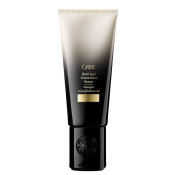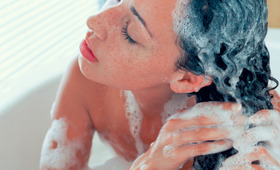
Let’s start with some bad news that many salon-goers already know: color processing of any kind can damage your hair (cue sad violin). The good news is that you don’t need to sacrifice soft, shiny, healthy-feeling locks to get the balayage of your dreams. While it’s true that you can’t technically “undo” damage to your hair fibers, you can repair it with the right tricks up your sleeve. And since we’re all staying at home anyway to help curb the spread of coronavirus, bringing your dry, brittle, over-processed hair back from the brink is the perfect weekend project. Set aside that sourdough starter and welcome to color-treated hair boot camp.
Day #1
To Do: Cleanse with a clarifying shampoo and do an oil treatment.
Products:
-
Clarifying shampoo
-
Hair oil
If your hair is damaged from too many trips to your colorist, you may have been staying away from clarifying shampoos. Normally, that’s a good call, but even color-processed hair needs the occasional reset. Buildup from products, pollution and sebum can cause dullness and scalp issues if you don’t keep it in check. For dyed hair, the key is finding a clarifying shampoo that isn’t too harsh.
R+Co Acid Wash ACV Cleansing Rinse is a gentle yet effective clarifying rinse powered by everyone’s favorite DIY hero, apple cider vinegar. For deeper scalp exfoliation, we also like Sunday Riley’s new Clean Rinse Scalp Serum. Focus on massaging shampoo into your scalp and roots—the product will drip down to cleanse the lengths of your hair on its own. Rinse thoroughly and gently dry your hair with a microfiber towel (T3 Luxe Turban Towel is an editor fave) or an old t-shirt to avoid roughing up your mane and causing frizz.
Next, grab a hair oil. Plain old coconut oil works, or you can use an oil treatment like Rene Furturer Karite Nutri Intense Nourishing Oil. Coat your damp hair in oil from root to tips and let it soak in for as long as possible—overnight is best. (If you do leave it in overnight, we recommend a showercap to keep your pillow from getting greasy.) If you’re in a rush, you can wrap your hair in plastic wrap or a showercap and apply low heat from your hairdryer to speed up the process.
Day #2
To Do: Restore moisture and protein with a good deep conditioning treatment.
Products:
- Deep conditioner or hair mask
Most color-treated hair needs a balance of moisture and protein to look and feel its best. Protein can help reinforce and temporarily fill in the gaps along the hair’s cuticle layer caused by chemical processing. Oribe Gold Lust Transformative Masque and R+Co Television Perfect Hair Masque are two popular picks packed with deeply moisturizing oils and damage-repairing proteins. If your hair feels very limp, mushy, or gummy, or if you’re experiencing breakage, you may need a more protein-rich treatment. Look for “strengthening” and “repairing” masks with high levels of hydrolyzed protein or keratin, like Raincry Rebuild Bond Repair.
Leave your deep conditioner on for at least an hour—the longer, the better.
Day #3
To Do: Start a color-protecting routine.
Products:
-
Color-protecting shampoo
-
Color-protecting conditioner
-
Leave-in conditioner
To keep your color looking fresh, invest in a good color-protecting shampoo and conditioner for regular use. If your hair is blond, grey, or if you’re worried about brassiness, swap in a purple shampoo or conditioner (like R+Co Sunset Blvd Blonde Shampoo) once a week to neutralize yellow and orange tones.
You should apply a leave-in conditioner after every wash. Look for one that will both moisturize and protect your hair from environmental damage—UV rays are notorious for messing up hair color. A solid contender is Briogeo Don’t Despair, Repair! Strength + Moisture Leave-In Mask, but Oribe Power Drops Color Preservation Booster is especially great if fading and sun exposure concerns for you.




























